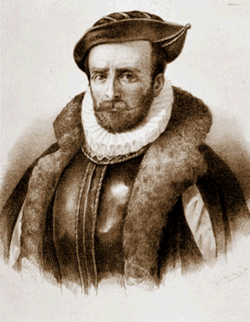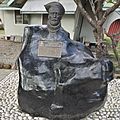Álvaro de Mendaña de Neira facts for kids
Quick facts for kids
Álvaro de Mendaña y Neira
|
|
|---|---|

Imaginary portrait by a 19th-century artist
|
|
| Born | 1 October 1542 |
| Died | 18 October 1595 (aged 53) |
| Nationality | Spanish |
| Occupation | Explorer, navigator, cartographer |
| Spouse(s) | Isabel Barreto |
Álvaro de Mendaña y Neira (born October 1, 1542 – died October 18, 1595) was a Spanish explorer and navigator. He is famous for two of the first journeys across the Pacific Ocean in 1567 and 1595. During his trips, he found islands like the Marquesas, Cook Islands, and Solomon Islands. Mendaña was born in Congosto, Spain. He was the nephew of Lope García de Castro, who was the viceroy (a ruler representing the king) of Peru.
Contents
Searching for New Lands
Between 1565 and 1605, several Spanish expeditions sailed from Peru into the southwest Pacific. One reason for these trips was the belief in a large southern continent, often called Terra Australis. A Spanish soldier named Pedro Sarmiento de Gamboa arrived in Peru in 1557. He heard stories from the Inca people about gold and riches from lands to the west.
Sarmiento suggested an expedition to find these lands. The viceroy, Lope García de Castro, liked the idea. He also thought these journeys could help keep peace. People who were causing trouble in the Spanish Americas were encouraged to join these trips. The hope of finding wealth made these expeditions attractive to many, especially those who were poor.
However, Sarmiento de Gamboa was disappointed. He was not made the leader of the expedition. Instead, command was given to the viceroy's nephew, Álvaro de Mendaña. Mendaña was younger and had less experience. Sarmiento was made the "Cosmographer," meaning he would study the stars and maps.
Sarmiento was mainly interested in finding riches. Mendaña, however, wanted to convert local people to Christianity. These different goals caused problems among the Spanish leaders even before they left.
Mendaña's First Voyage (1567-1569)
Two ships, the Los Reyes (the main ship) and the Todos Santos (the second ship), left Callao, Peru, on November 20, 1567. About 150 sailors, soldiers, priests, and slaves were on board.
In mid-January, they saw a small island, probably Nui in what is now Tuvalu. On February 7, 1568, they sighted a larger land. This was Santa Isabel Island, part of the Solomon Islands. They named these islands Islas Salomon.
At first, the Spanish had friendly contact with the Solomon Islanders. But the Spanish needed fresh food and water. The islanders could not provide enough supplies for long. This led to tension and conflict. The Spanish especially wanted pigs, which were also very important to the local people. The Spanish were shocked by some of the islanders' customs regarding food.
The Spanish built a small boat and explored nearby islands like Malaita, Guadalcanal, Makira (named San Cristobal), and Choiseul Island. However, trying to trade for food often led to problems. There were misunderstandings, arguments, and sometimes violence.
On August 7, 1568, the leaders decided to return to Peru. Mendaña wanted to sail further south. But Sarmiento and some soldiers wanted to start a colony. Their idea was not chosen.
The two ships sailed north and then east. They passed the Marshall Islands and Wake Island. They reached the Mexican coast in late January 1569. It was a very long and difficult journey. Many people died from scurvy, a disease caused by lack of vitamin C.
Results of the First Voyage
The most important result was that Europeans learned about the Solomon Islands and Tuvalu. The Spanish sailors also gained valuable experience crossing the huge South Pacific. These discoveries encouraged more expeditions to search for the Great South Land, or Terra Australis. Mendaña himself led another trip, and so did Pedro Fernandes de Queirós.
However, the Great South Land was not found yet. The Solomon Islands did not have much gold or spices. The people there were not converted to Christianity. One family of Solomon Islanders taken by the Spanish did become Christians in Peru.
Mendaña's Second Voyage (1595-1596)
Mendaña spent years trying to get support in Spain and Peru for a new, larger expedition. By the early 1590s, a big trip was planned. Four ships and 378 people (men, women, and children) were to go and start a colony in the Solomon Islands.
Again, the leaders of this journey had very different personalities. Mendaña was in charge. His wife, Doña Isabel Barreto, her three brothers, and a sister joined him. The main pilot was a young Portuguese navigator working for Spain, Pedro Fernandes de Queirós. An old, argumentative soldier named Pedro Merino Manrique was chosen as the camp master. Manrique caused problems even before the ships left.
The four ships—the San Gerónimo (main ship), the Santa Ysabel (second ship), the smaller Santa Catalina, and the San Felipe—left Callao on April 9, 1595. Everyone was hopeful at first, and fifteen marriages were even celebrated. Mendaña had Queirós draw maps for his captains that only showed Peru and the Solomon Islands.
On July 21, 1595, the ships reached the Marquesas Islands. These islands were named after the wife of the viceroy of Peru. Four hundred people in canoes met them. The Spanish admired their appearance. But relations with the local people soon became difficult. When the expedition left two weeks later, Queirós estimated that 200 Marquesans had been killed.
Mendaña was sure the Solomon Islands were close. But they did not see land again until September 8. This time it was Nendo, which they named "Santa Cruz." The Santa Ysabel ship had disappeared, and they could not find it.
They arrived at Graciosa Bay and began to build a settlement. Relations with the local islanders and their chief, Malope, started well. The islanders provided food and helped build structures. However, the Spanish settlers became sick, possibly with malaria. Many people died. Manrique was murdered on Mendaña's orders. Soon after, Malope was killed by soldiers. Relations with the islanders quickly worsened.
The settlement began to fail due to sickness and arguments among the Spanish. Mendaña himself died on October 18, 1595. He left his wife, Doña Isabel Barreto, in charge. Her brother Lorenzo became the new captain-general. On October 30, they decided to leave the settlement. When the three ships departed on November 18, 1595, forty-seven people had died in just one month.
Pedro Fernandes de Queirós is praised for guiding the San Gerónimo safely to the Philippines. He arrived in Manila Bay on February 11, 1596. More than fifty people died on the twelve-week journey from Santa Cruz. This was partly because of a lack of food. It was also said that Doña Isabel refused to share her private food and water. The frigate carrying Mendaña's body disappeared during the voyage. The San Felipe arrived in the southern part of Mindanao a few days later.
After the Voyages
Out of the 378 people who sailed from Peru, about 100 survived. But ten more died soon after reaching Manila. Doña Isabel Barreto was honored in Manila. Queirós was praised for his service. He was not blamed for the killings on Santa Cruz. Three months later, Doña Isabel married the governor's cousin. She kept trying to organize another trip back to the Solomon Islands. She died in 1612.
Back in Peru in June 1597, Queirós began planning to return to the Solomon Islands. He led the next Spanish expedition in 1605. This trip was also not successful in starting a colony. But it led to the discovery of the Pitcairn Islands and Vanuatu. Queirós visited the Solomons in 1606 but could not establish a settlement. Outsiders did not visit the Solomon Islands again until 1767. That's when Philip Carteret saw Santa Cruz and Malaita islands.
The story of Mendaña's voyage is told in The Islands of Unwisdom, a historical novel by Robert Graves.
Images for kids
-
Bust at Solomon Island museum at Point Cruz
See also
 In Spanish: Álvaro de Mendaña para niños
In Spanish: Álvaro de Mendaña para niños


